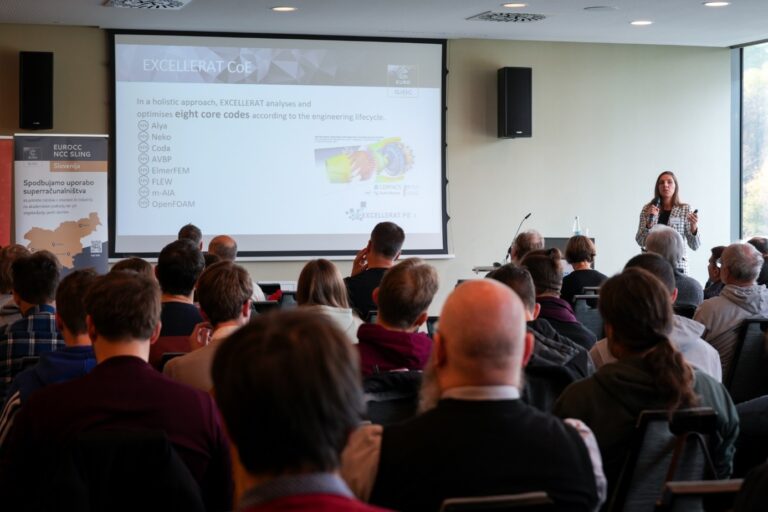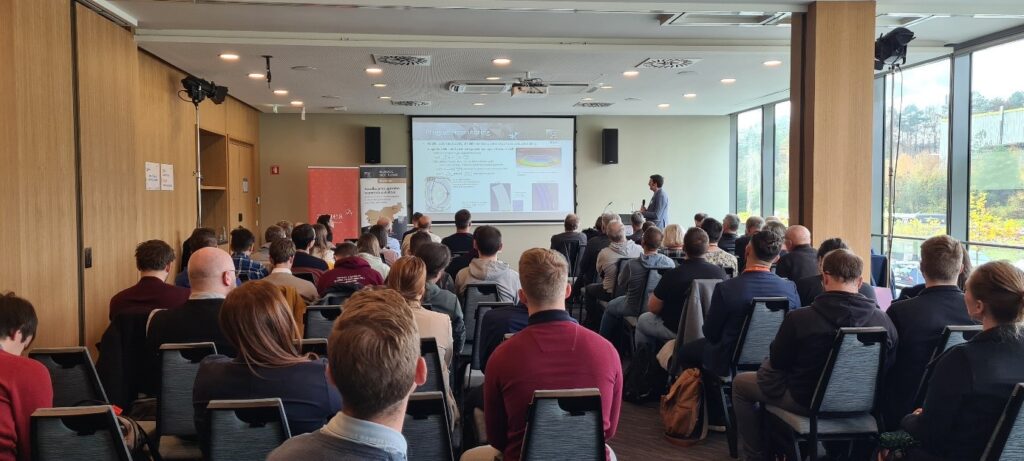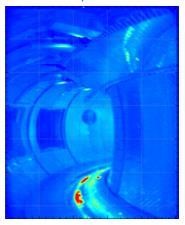EXCELLERAT CoE presented at the
Day of the Slovenian Supercomputer Network
On Thursday, November 16, 2023, the “Day of the Slovenian Supercomputer Network” was organized by the National Competence Center SLING in Ljubljana, Slovenia. One of the biggest HPC events in Slovenia gathered visitors from the entire HPC value chain.
The varied program included presentations on the activities of the National Competence Center (NCC) and Centers of Excellence (CoEs). Furthermore, examples of the effective use of powerful supercomputers in industry and academia were presented by research institutions and companies, and the possibilities of accessing HPC infrastructure were explained.
This event offered a pleasant opportunity to present the EXCELLERAT CoE and foster collaboration with the NCC SLING. Tina Crnigoj Marc, project manager from Arctur, and Matic Brank, Assistant at the Laboratory for Engineering Design and supercomputing LECAD-UL, contributed to the Centers of Excellence Session and presented the EXCELLERAT CoE as the main entry point for engineering stakeholders to access experts, services, and knowledge. As the engineering sector is very demanding when talking about HPC resources, EXCELLERAT partners are working on providing expertise in data management, data analytics, visualisation, simulation-driven design, and Co-design with Exascale computing. This will solve highly complex and costly engineering problems and create enhanced technological solutions even at the development stage.

At the CoE Session, Matic Brank contributed to the EXCELLERAT presentation with a detailed introduction of one of the seven EXCELLERAT use cases titled “Engineering design and digital twin of the first wall of a tokamak fusion reactor.” This use case involves full 3D simulation of plasma deposition to the first wall and corresponding signal capture by the IR camera with the focus on tokamaks WEST (IRFM CEA Cadarache) and ITER. The main purpose of creating the tokamak digital twin is to better understand and control plasma power deposited to first wall. Along with this, the digital twin allows reaching a deeper understanding of the
physical processes around the inner wall during the fusion reactions, possibly leading to real-time control of the fusion reaction, as it provides a unique insight into particle movement and heated areas in the tokamak.

In more detail, one of the goals of nuclear fusion reactors is to constantly monitor the temperature distribution of the inner wall using IR cameras to detect in real-time overheating parts allowing reacting before any damage occurs. Due to highly reflective materials in a fusion reactors the IR camera signal is difficult to interpret correctly since reflected light can create so called hot-spots which leads to false interpretation of camera signals. To better understand and interpret the
IR camera signals correctly, three types of simulations are performed to arrive at the syntetic (i.e. simulated) signal on the IR camera. First, a filed line tracing algorithms are used to determine heat fluxes to first wall. Then the heat equation is solved to obtain corresponding temperatures. This is modeled with Finite Element Methods, i.e., via the Elmer FEM code and with Finite Volume Methods, i.e., via OpenFOAM. Finally, the optical performance of visible light and infra-red cameras is simulated, based on Monte Carlo methods using forward ray-tracing algorithms to predict the optical flow. Optical parameters such as surface reflectivity are modeled with Cook-Torrance models, which are assessed with ray-tracing codes. The goal of the simulations is to accurately predict stray light, hot spots, and uniformity. Since cameras do not only see surface temperature but also reflected light from other surfaces, coupled thermal-optics simulations under high reflectance are used to correctly describe the visible light: when reflections are subtracted, correct surface temperatures are determined. Therefore, only complete simulations (namely, digital twins) can give correct results to be seen by cameras.
Centres of Excellence: supporting research and innovation actions towards Exascale
Three other CoEs were presented at the Day of the Slovenian Supercomputer Network conference:
MultiXscale is a new CoE, which started in January 2023 and is co-financed through the Horizon Europe programme by EuroHPC JU. Its aim is to increase the
performance, productivity, and portability of software and workflows for the full spectrum of scientists working in the field of multiscale simulation, while its goal is to encourage the community to adopt battle-tested, future-oriented, scalable workflows, and portable technologies.
MAX (MAterials design at the eXascale) was established in the same period as EXCELLERAT, with its mission to develop the technologies and make them available for a large and growing base of researchers in the materials domain. CoEs are investing major efforts in optimizing the codes and the data ecosystem to take advantage of this new computational power at the exascale level.
Plasma-PEPSC started in February 2023 and supports plasma science through exascale computing and extreme-scale data analytics. Despite codes optimisation and parallelisation, partners will build on algorithmic advances (regarding load balancing, resilience, and data compression) as well as on programming model and library developments (MPI, accelerator and data movement APIs and runtimes, in-situ data analysis).
Background
Between 2018 and 2022, 15 CoEs were established under the European Union’s Horizon 2020 research and innovation programme and are not only promoting the
use of upcoming exascale and extreme performance computing capabilities and scale up existing parallel codes towards exascale scaling performance but also filling the gaps in knowledge by offering training, consulting and other services to academia and industry. To continue their fruitful mission, 10 new CoEs were launched and are funded by Horizon Europe, the EU funding programme for research and innovation with a total budget of up to EUR 90 million including up to EUR 45 million of EU contribution to be matched by equivalent national contributions. The running CoEs collectively manage about 60 HPC codes/pilots, and for each code/pilot they need access to several JU systems. All CoEs have the opportunity to test and co-design some codes on the European flagship EuroHPC machines, such as LUMI, LEONARDO, MareNostrum 5 and Vega.

